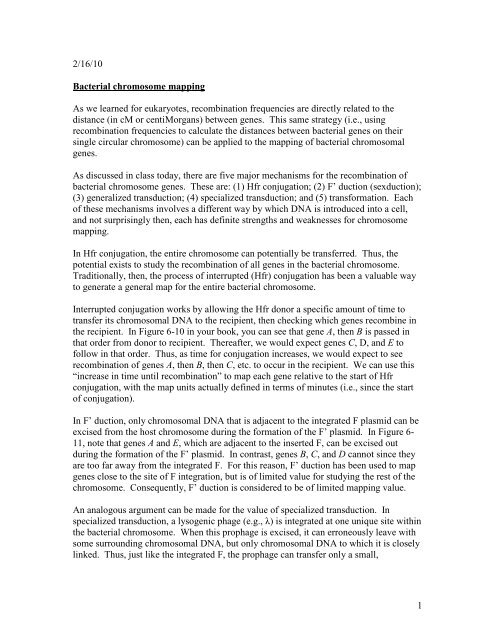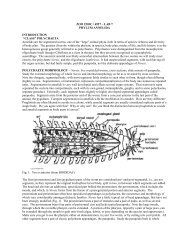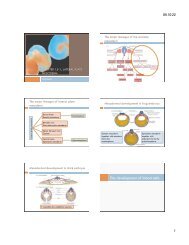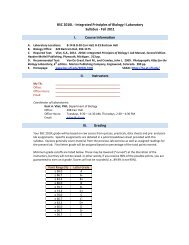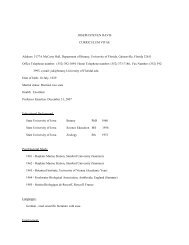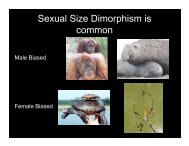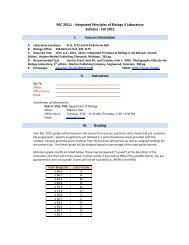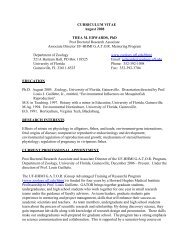1 2/16/10 Bacterial chromosome mapping As we ... - Biology Major
1 2/16/10 Bacterial chromosome mapping As we ... - Biology Major
1 2/16/10 Bacterial chromosome mapping As we ... - Biology Major
Create successful ePaper yourself
Turn your PDF publications into a flip-book with our unique Google optimized e-Paper software.
2/<strong>16</strong>/<strong>10</strong><strong>Bacterial</strong> <strong>chromosome</strong> <strong>mapping</strong><strong>As</strong> <strong>we</strong> learned for eukaryotes, recombination frequencies are directly related to thedistance (in cM or centiMorgans) bet<strong>we</strong>en genes. This same strategy (i.e., usingrecombination frequencies to calculate the distances bet<strong>we</strong>en bacterial genes on theirsingle circular <strong>chromosome</strong>) can be applied to the <strong>mapping</strong> of bacterial chromosomalgenes.<strong>As</strong> discussed in class today, there are five major mechanisms for the recombination ofbacterial <strong>chromosome</strong> genes. These are: (1) Hfr conjugation; (2) F’ duction (sexduction);(3) generalized transduction; (4) specialized transduction; and (5) transformation. Eachof these mechanisms involves a different way by which DNA is introduced into a cell,and not surprisingly then, each has definite strengths and <strong>we</strong>aknesses for <strong>chromosome</strong><strong>mapping</strong>.In Hfr conjugation, the entire <strong>chromosome</strong> can potentially be transferred. Thus, thepotential exists to study the recombination of all genes in the bacterial <strong>chromosome</strong>.Traditionally, then, the process of interrupted (Hfr) conjugation has been a valuable wayto generate a general map for the entire bacterial <strong>chromosome</strong>.Interrupted conjugation works by allowing the Hfr donor a specific amount of time totransfer its chromosomal DNA to the recipient, then checking which genes recombine inthe recipient. In Figure 6-<strong>10</strong> in your book, you can see that gene A, then B is passed inthat order from donor to recipient. Thereafter, <strong>we</strong> would expect genes C, D, and E tofollow in that order. Thus, as time for conjugation increases, <strong>we</strong> would expect to seerecombination of genes A, then B, then C, etc. to occur in the recipient. We can use this“increase in time until recombination” to map each gene relative to the start of Hfrconjugation, with the map units actually defined in terms of minutes (i.e., since the startof conjugation).In F’ duction, only chromosomal DNA that is adjacent to the integrated F plasmid can beexcised from the host <strong>chromosome</strong> during the formation of the F’ plasmid. In Figure 6-11, note that genes A and E, which are adjacent to the inserted F, can be excised outduring the formation of the F’ plasmid. In contrast, genes B, C, and D cannot since theyare too far away from the integrated F. For this reason, F’ duction has been used to mapgenes close to the site of F integration, but is of limited value for studying the rest of the<strong>chromosome</strong>. Consequently, F’ duction is considered to be of limited <strong>mapping</strong> value.An analogous argument can be made for the value of specialized transduction. Inspecialized transduction, a lysogenic phage (e.g., λ) is integrated at one unique site withinthe bacterial <strong>chromosome</strong>. When this prophage is excised, it can erroneously leave withsome surrounding chromosomal DNA, but only chromosomal DNA to which it is closelylinked. Thus, just like the integrated F, the prophage can transfer only a small,1
neighboring fraction of the entire <strong>chromosome</strong>. For this reason, as for F’ duction,specialized transduction is of limited <strong>mapping</strong> value.In contrast, in generalized transduction, any <strong>chromosome</strong> fragment of one cell can beincorporated into the head of a lytic phage and thereby potentially be transferred toanother cell. Since any fragment can be passed, the entire bacterial <strong>chromosome</strong> can besampled and thereby mapped. For this reason, generalized transduction has proven quiteuseful for <strong>mapping</strong> the entire bacterial <strong>chromosome</strong>.Similarly, transformation behaves like generalized transduction and has therefore been ofvalue for <strong>mapping</strong> the entire bacterial <strong>chromosome</strong>. In transformation, any <strong>chromosome</strong>fragment can be picked up by another cell, thus any chromosomal region can berecombined in the new cell. <strong>As</strong> for generalized transduction, then, transformation cansample and thereby map the entire bacterial <strong>chromosome</strong>.To recap, Hfr conjugation has proven useful for generating general maps of the entirebacterial <strong>chromosome</strong>. In turn, generalized transduction and transformation have provenuseful for adding details about the entire bacterial <strong>chromosome</strong> to these maps. Incontrast, F’ duction and specialized transduction have been of limited utility, since theyinvolve only DNA regions around the integration sites of the F plasmid and the lysogenicphage, respectively.2


